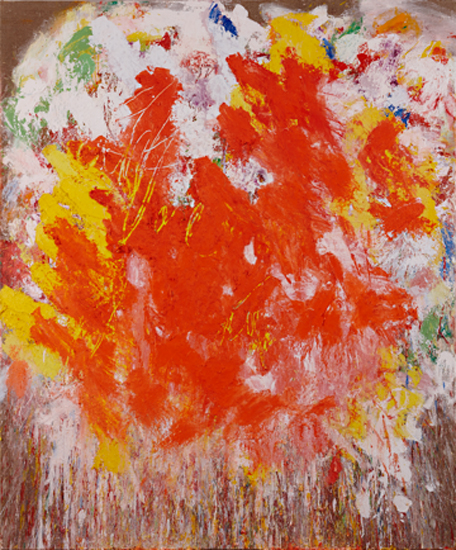From Sharne Wolff…
Eyes in the Heat is the title of a 1946 all-over painting by Jackson Pollock. It’s also the name of Aida Tomescu’s latest exhibition and a featured three metre painting that more than doubles the size of its namesake. In Pollock’s painting, pairs of eyes float below its intensely painted surface – as if there were something, or someone, lurking just below. Similarly, the bright orange and yellow atolls that drift across Aida Tomescu’s canvas dominate a myriad of underlayers. With qualities that oscillate between delicate and solid, these patches of colour restrain the picture while the explosion of life below escapes around the edges.
Aida Tomescu, Helios, 2015. Oil on linen, 183 x 153cm.
Since moving to Australia from Bucharest in 1980, Tomescu’s work has been shown in more than 30 solo exhibitions. Every major Australian institution has collected her work and a lengthy CV is also crammed with enviable lists of her inclusion in international art fairs, events and awards. Despite being her largest ever painting, Eyes in the Heat took less time to produce than some of the smaller works, which are the product of two or three years struggle. Tomescu notes that it couldn’t have been made without first painting smaller works such as Helios and Eyes in the Heat II. Interestingly, the scale and physicality of all of these tough, gutsy paintings seem at odds with the artist’s slight stature.
Considered by many to be an ‘artist’s artist’, Tomescu identifies process as the most important part of her practice. Knowing where to make the right marks, when to modify or fine tune, and when to stop is when time and fortitude become her allies. Ironically this wisdom also enables Tomescu’s apparent spontaneity – visualised as thickly painted gestures and quickly scratched surfaces that flare and rupture across the canvas, the rival qualities of wildness and control materialise in Tomescu’s work. Despite appearances, Tomescu’s powerful paintings require enormous amounts of discipline.
Tucked around the corner of the room are two canvases dominated by a range of pale blues. Both titled Bribie, one painting was Tomescu’s Wynne Prize entry while the other also recalls the Queensland island home of artist Ian Fairweather. Of her Wynne entry Tomescu noted, “I wanted to convey something of the light of this landscape and the wondrous distribution of its elements and arrive at a painting that looks as if it just landed on canvas where it has always belonged.” Unlike many of the other works, it’s in these two paintings where the subject of landscape sneaks in to the work. While the acknowledgement of landscape is initially made palpable through Tomescu’s palette, it also shows up in soft textures and the shape of her gestural marks.
By contrast, the shocks of dark red in paintings such as Heartland I and II remain resistant to any prescribed narrative. Once drawn in by the dramatic swathes of thick impasto, the eye wanders off in an endless adventure around the canvas. Replicating the manner in which they’re made, Tomescu’s paintings are best revealed slowly and over time. Just as good food can be time consuming and difficult to make, it’s always best when eaten at an unhurried pace.
Until November 28, Sullivan and Strumpf Fine Art, Zetland

